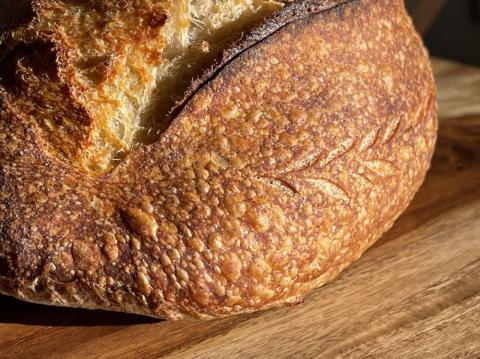
Saccharified Polenta Sourdough

A recent blog post about grain mash is awesome if you haven’t read it yet. Reading it motivated me to apply saccharification to the polenta porridge thinking it might enhance the flavour of the polenta. As you know saccharification of the polenta brings out its sweetness that is hidden in the starches in the polenta. Adding the diastatic malt and holding it at a warm, but not too warm temperature will allow the diastatic malt (amylase) to break down theses starches to sugars which we will be able to taste as the natural sweetness in the polenta that otherwise would be hidden from our tastebuds.
I used my Instant Pot and after a bit of experimentation found that using its Keep Warm setting Normal holds a temperature of 148°F for up to ten hours. After cooking the polenta I placed it into a jam jar lightly capped and placed it into a water bath in the instant pot and cooked it for 6 hours. Comparing the flavour pre and post water bath the difference was remarkable. After six hours the porridge had a lovely sweetness that wasn’t there prior to the six hours at 148°F. When using the Instant Pot for this saccharification process put the lid on but keep the vent open so there is no pressurization of the pot.
Cook coarse corn meal with the water until softened and water fully absorbed. Once the temperature is down to 150°F or less add the diastatic malt and mix well.
Place the corn porridge in a jar, covered lightly and place in a water bath in an instant pot. Set to [keep warm] normal (148ºF) for 3-6 hours. I did 6 hours.
Build levain overnight with the aim to be at peak in the morning. At 76°F 3x rise and dome flattening at 11 hours.
Add water and salt to the bowl of a stand mixer, dissolve salt. Add the stiff levain and break into small pieces. Add the bread flour, mix on speed 1 until no dry flour remains. Rest for 10-15 mins. At medium speed mix to develop the gluten. When the gluten is moderately to well developed add the polenta porridge in small aliquots. Mix until well incorporated.
Bulk fermentation aiming for 40% rise to shape. Perform coil folds every 30 mins until dough is strong and isn’t spreading.
Once the pH has dropped by 1.0 then shape the dough into a batard and then start final proofed shaped and resting in a banneton.
Once the pH has dropped by a further 0.3 it will be time for baking. Place the dough in the freezer when the pH drops by 0.25 and then pre-heat oven at 500°F with cast iron skillet in the oven and set up for open steam baking. 30 mins prior to baking, pour 1 L of boiling water into metal loaf pan with Sylvia towel and place on baking steel on the lowest rack of the oven.
Once oven reaches 500ºF turn dough out of banneton, brush excess rice flour off, score and then brush with water. Transfer to oven. Pour 250 mL of boiling water into the cast iron skillet on a high shelf, high enough that the dough have fully bloom. Drop temperature to 450ºF and bake with steam for 25 mins. Then vent oven and remove all steaming gear and drop temperature to 425ºF. Bake for another 25-30 mins rotating as needed.











Comments
Thank you that is very of you to say.
Benny
Wow, just came across this Benny. How characteristically gorgeous and the design is wonderful. Thank you, I'd like to try it.
Thank you Paul that is kind of you to say. Just keep in mind during saccharification, the polenta seems to get wetter so you’ll need to watch your hydration to compensate.
Benny
looks very good
Thank you very much.
Benny
Hi Benny-I am so glad you tried this and most of all happy for your great results. I use such mashes in most of my breads and I've found many different ways to incorporate mashes into my breads and the flavors and textures are altered in a positive way. I recently made a thirded bread using a mash---the thirded bread is a precursor to Boston Brown bread and anadama and the crumb turns a lovely shade of dark red and jet black as the blue cornmeal turns red like litmus paper because of the rye sour. The flavor notes of the bread are chocolate and caramel , but no chocolate nor caramel were hurt in the making of this bread. Using the 4 stage process has never resulted in gummy bread. The suggestion of heating up the scald to a high heat is an old way of preventing gumminess but I never do this.
George the thudded bread sounds interesting have you posted your formula anywhere?
Benny
Pages